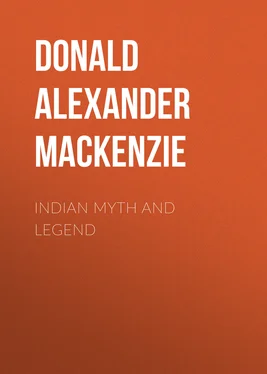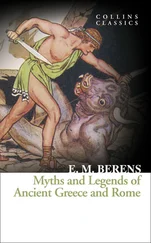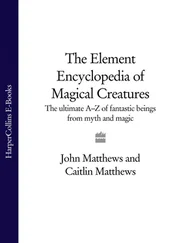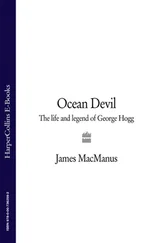Donald Alexander Mackenzie - Indian Myth and Legend
Здесь есть возможность читать онлайн «Donald Alexander Mackenzie - Indian Myth and Legend» — ознакомительный отрывок электронной книги совершенно бесплатно, а после прочтения отрывка купить полную версию. В некоторых случаях можно слушать аудио, скачать через торрент в формате fb2 и присутствует краткое содержание. Жанр: foreign_prose, foreign_religion, Философия, Мифы. Легенды. Эпос, foreign_psychology, foreign_antique, на английском языке. Описание произведения, (предисловие) а так же отзывы посетителей доступны на портале библиотеки ЛибКат.
- Название:Indian Myth and Legend
- Автор:
- Жанр:
- Год:неизвестен
- ISBN:нет данных
- Рейтинг книги:4 / 5. Голосов: 1
-
Избранное:Добавить в избранное
- Отзывы:
-
Ваша оценка:
- 80
- 1
- 2
- 3
- 4
- 5
Indian Myth and Legend: краткое содержание, описание и аннотация
Предлагаем к чтению аннотацию, описание, краткое содержание или предисловие (зависит от того, что написал сам автор книги «Indian Myth and Legend»). Если вы не нашли необходимую информацию о книге — напишите в комментариях, мы постараемся отыскать её.
Indian Myth and Legend — читать онлайн ознакомительный отрывок
Ниже представлен текст книги, разбитый по страницам. Система сохранения места последней прочитанной страницы, позволяет с удобством читать онлайн бесплатно книгу «Indian Myth and Legend», без необходимости каждый раз заново искать на чём Вы остановились. Поставьте закладку, и сможете в любой момент перейти на страницу, на которой закончили чтение.
Интервал:
Закладка:
Another aspect of Sanskrit literature is the feeling of the poets for Nature. These voluminous writers revelled in the luxuriant loveliness and splendour of Indian forests, and the charms of gleaming valleys and serene, snow-capped mountains; even the gods loved to hear the hum of insects and the songs of melodious birds, and, like mortals, to gather flowers of sweet scents and brilliant colours. Hundreds of songs were sung in praise of the lotus blooms that gemmed the clear waters of lakes and ponds, and Paradise was pictured as a jungle of beauty, fanned by soft winds, radiant with blossoms, and ever vocal with music and song. To illustrate this phase of India's classic literature, we reproduce at length the representative story of Nala with much of its poetic details.
The civilization revealed by the narrative poems was of no mean order. The ancient Aryans were chivalrous knights. No such barbaric incident occurs in the Mahábhárata battles as when in the Iliad the victorious Achilles drags behind his chariot the body of the slain Hector. When Arjuna, the Indian Achilles, slays Karna, the Indian Hector, he honours his fallen foe and performs those rites at the funeral pyre which assures the dead hero immortal bliss in Paradise. When, again, Arjuna mortally wounds Bhishma, he procures water to quench the thirst of his dying opponent. Even the villains are not without their redeeming qualities. Duryodhana of the Mahábhárata , who consents to the slaughter of his sleeping rivals, dies with grief because the innocent children of his enemies were slain. Rávana, the demon king of Ceylon, touches us in the Rámáyana by his grief for his son, who was slain fighting against Laksmana, brother of Rama.
To appreciate fully the sacred and romantic literature of India, we should follow the advice of Robert Louis Stevenson. “To learn aright from any teacher,” he wrote, “we must first of all, like a historical artist, think ourselves into sympathy with his position.” And if in endeavouring to understand the religious conceptions of the ancient forest sages, we, at times, find ourselves in difficulties, it may be that “if a saying is hard to understand, it is because we are thinking of something else”—we are looking on India with European eyes and with European prejudices. “There is always”, said Stevenson, “a ruling spirit behind the code of rules, an attitude, a relation, a point of the compass, in virtue of which we conform or dissent.” 41
We are confident that our readers who peruse with sympathy and, we hope, with enjoyment, the chapters which follow, will feel themselves drawn closer than hitherto to the millions of our fellow subjects in the great dependency of the British Empire, by whom Rama and Yudhishthira are regarded as ideal types of strong manhood, and Savitri and Sita as perfect women and exemplary lovers and wives.
3
A VYASA, OR PUBLIC READER, RECITING THE MAHABHARATA
CHAPTER I
Indra, King of the Gods
Types of Hammer Gods—The Aryan Indra—Chinese World Shaper—Scottish Hunting Deity—Egyptian Artisan God—Greek and Roman Thunder Gods—Thor—Hittite, Assyrian, and other types—A Wail from Palestine—Babylonian Influence—Indra's Indian Character—A Nature Myth—Drought Demon slain—Gods and Demons in conflict—Origin of Indra's Thunderbolt—Demons' plot to destroy Universe—Babylonian Creation Myth—How Indra Shaped the World—Elfin Artisans in India, Egypt, and Germania—Babylonian Artisan God—Indra the Harvest God—The God of Battle—Comparison with Thor—Aryan Cattle Lifters—Indra's Queen and Attendants.
The ancient Eur-Asian “hammer god”, bearing the tribal name of Indra, accompanied the earliest invading bands of hunting and pastoral Aryans, who hailed with joy the “fresh woods and pastures new” of the Punjab, the green country of “Five Rivers”. This deity of wanderers and invaders was already of great antiquity and wide distribution; his attributes were in accord with the habits and ideals of his worshippers; they multiplied with the discoveries of man and were ever influenced by the conditions prevailing in new areas of localization. He was the Thunderer who brought rain to quicken dried-up pasture lands; he was the god of fertility, and he became the corn spirit; he was “the friend of man”; he was the artisan of the Universe which he shaped with his hammer, the dragon slayer, the giant killer, the slaughterer of enemies, the god of war. His racial significance must ever remain obscure. We cannot identify his original home, or even fix with certainty the archæological period in which he first took definite shape. It is possible that he may have been invoked and propitiated by Neolithic, or even by Palæolithic, flint knappers who struck fire from stone long ere they suspected the existence of metal; the primitive hunting and pastoral wanderers may have conceived of a thunder deity engaged in splintering the hills with his stone hammer, and fighting demons in the rude manner in which they themselves contended against beasts of prey. Memories of the Stone Age cling to the hammer god. Indra's bolt was “the all-dreaded thunderstone” of Shakespeare's lyric; until recently Palæolithic and Neolithic artifacts were reputed to be “elf bolts” and “thunder bolts” which fell from the sky; in Scandinavian folklore “the flint hills” are the fragments of the weapon wielded by the thunder giant Hrungner. The bolt or hammer ultimately became an axe; and according to the modern Greeks, lightning flashes are caused by the blows of the “sky axe” (astropeléki); Scottish Gaelic retains an immemorial reference to the “thunder ball” (peleir-tarnainaich).
The hammer god's close association with hilly countries suggests that he was first worshipped on the steppes and then distributed by the nomads whose migrations were propelled by changing climatic conditions. He is found as far east as China, where, as P'an Ku, the dwarfish “first man”, he smites primeval rocks with his thunder hammer while engaged in the work of shaping the hills; he is found as far west as Scotland, where, as the hunting giant Finn-mac-Coul, “in height sixty feet”, he strikes with his hammer, “Ord na Feinne”, such mighty blows on his shield that he is heard by his followers in Lochlann (Scandinavia). From ancient Egypt come distant echoes of the world artisan Ptah, now a dwarf and anon a giant, who hammers out the copper sky, suggesting the presence in Memphis of early Asian settlers at the very dawn of history. In southern Europe the deity is Zeus-pater (Jupiter), the sublime wielder of the thunderbolt; in northern Europe he is lusty Thor, hurling Mjolner through the air against Jotuns, or cleaving valleys with it in the mountain range which he mistook for the giant Skrymer. We find the hammer god as Tarku among the Hittites; he is Indra in Mitanni as in the Punjab; he is Rammon, or Adad, who is carried aloft in triumph by the soldiers of Assur-banipal, the Assyrian Emperor; he is remembered in Palestine by the wail of Naaman, who cried: “When my master goeth into the house of Rimmon to worship there, and he leaneth on my hand, and I bow myself in the house of Rimmon: when I bow down myself in the house of Rimmon, the Lord pardon thy servant in this thing....” 42The thunder god is also known in Babylon, which received many of its settlers from the hills of Elam and where Kassites, associated with Aryans, established a dynasty after successful invasion, prior to the discovery of the Punjab. The authorities are agreed that Aryan culture shows traces of Babylonian influence; it does not follow, however, that Indra is of Babylonian origin.
But although his name, which has been deciphered as “In-da-ra” at Boghaz-Köi in Asia Minor, may belong to the early Iranian period, the Vedic “King of the gods” assumed a distinctly Indian character after localization in the land of the “Five Rivers”; he ultimately stepped from his chariot, drawn by the steeds of the Aryan horse tamers, and mounted an elephant; his Heaven, called Swarga, which is situated on the summit of Mount Meru, eclipses Olympus and Valhal by reason of its dazzling Oriental splendour; his combats are reflections of the natural phenomena of Hindustan.
Читать дальшеИнтервал:
Закладка:
Похожие книги на «Indian Myth and Legend»
Представляем Вашему вниманию похожие книги на «Indian Myth and Legend» списком для выбора. Мы отобрали схожую по названию и смыслу литературу в надежде предоставить читателям больше вариантов отыскать новые, интересные, ещё непрочитанные произведения.
Обсуждение, отзывы о книге «Indian Myth and Legend» и просто собственные мнения читателей. Оставьте ваши комментарии, напишите, что Вы думаете о произведении, его смысле или главных героях. Укажите что конкретно понравилось, а что нет, и почему Вы так считаете.












